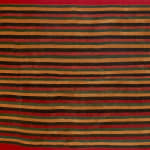




Nazca/Huari Culture
81'8" x 55'9" in.
Further images
This tunic has been opened up to display both sides as it would have appeared to the artist weaving it on their loom. It bears a bold striped colour field composition, one of the many geometric forms that became predominant in the early Nazca and later Huari period. Here the polychromatic stripes create a large-scale almost optical structure. The ancient Andean artists endlessly exploited the multiple possibilities of strips, squares and rectangles.
This well-preserved tunic brings us clearly into the field of abstract or Colour-Field art. We should not discard the possibility that this stunning abstract design was not merely the creation of people whose sharp eye, intuitive sense of colour and composition, and uncompromising originality, rather, was also an aesthetic solution which happens to coincide with our own criteria of beauty in the twentieth century.




